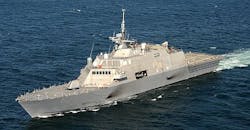Navy to buy rugged VME chassis from Kontron for littoral combat ships, missile-defense radar
JOINT BASE MCGUIRE-DIX-LAKEHURST, N.J., 18 Dec. 2012. U.S. Navy shipboard electronics experts needed rugged VME chassis assemblies for an identification-friend-or-foe (IFF) system aboard Navy littoral combat ships and U.S. Coast Guard national security cutters. They found their solution from Kontron America Inc. in Poway, Calif.
Kontron will receive a contract to provide 25 FS-1290 rugged VME chassis assemblies for embedded computing in AN/UPX-29A interrogator systems aboard the littoral combat ships USS Little Rock (LCS 9) and USS Sioux City (LCS 11), as well as aboard the national security cutter USCGC Midgett (WMSL 756).
Awarding the contract are officials of the Naval Air Warfare Center Aircraft Division Lakehurst, at Joint Base McGuire-Dix-Lakehurst, N.J. The amount of the contract, which was announced last Friday, has not been negotiated yet.
Kontron also will provide rugged VME chassis assemblies for AN/UPX-29A interrogator systems that are part of Navy AN/TPS-59(V)3 radar systems.
The Navy is buying the FS-1290 VME chassis on a sole source basis from Kontron because is the only known assembly that provides the necessary shock and vibration isolation, electromagnetic interference protection, and environmental effects protection for the AN/UPX-29A system while also maintaining compatibility with the currently fielded systems, Navy officials say.
AP Labs -- acquired by Kontron in 2010 -- is the original manufacturer of the FS-1290 VME chassis, which houses the circuit card assembles and custom wiring harness of the AN/UPX-29A interrogator system, Navy officials say.
Kontron remains the only company with proprietary data for the chassis, including the patented card slides of the AN/UPX-29A for MIL-S-901D qualification and electrical compatibility with existing circuit card assemblies.
The AN/UPX-29(V) interrogator is a centralized air traffic control radar beacon system IFF Mark XII/Mark XIIA system that uses a challenge-and-reply technique to distinguish friendly ships and aircraft.
The AN/UPX-29 generates identity queries on specific or general targets and processes target responses to obtain identification. An electronically steered antenna provides immediate interrogations of pop-up targets.
The AN/UPX-29 also can convert analog data from conventional IFF operation into digital data, process and store as many as 400 targets, provide instantaneous interrogation on a target within 25 microseconds, provide electronic evaluation of Mode 4 replies, provide operator-designated target information from data storage, provide simultaneous display of IFF targets synchronized with as many as four radars at 22 displays, provide sector interrogation capability, and interface with shipboard computer control systems.
AN/UPX-29 control can come from as many as 22 manually operated display positions, one semi-automatic operating position, and one shipboard computer-controlled interface.
The AN/TPS-59(V)3 radar can detect and track long-range aircraft and tactical missiles within 300 nautical miles, as well as tactical ballistic missiles at ranges of 400 nautical miles for 360 degrees at altitudes as high as 190 miles.
The radar control shelter has two-position display consoles that provide a plan position indicator display, range height indicator display, or both simultaneously. The radar's 54 transmitters are arranged in 54 rows and operate independently of each other. The radar can also operate in the two-dimensional mode should its general-purpose computer fail.
For more information contact Kontron America online at www.Kontron.com, or the Naval Air Warfare Center Aircraft Division Lakehurst at www.navair.navy.mil.

